The Importance of a Logo for Your Small Business
Learn the key reasons why your logo is vital to your business's success
 February 14, 2023
February 14, 2023 12 minute reading
12 minute reading
Three-quarters of consumers can recognize a brand by its logo alone. As a result, a logo is the single most important visual element of any brand identity. Yet, some small business owners fail to recognize this importance and instead opt for a basic logo that doesn't accurately represent their brand.
In this guide, we reveal the key reasons why your logo is vital to your business's success. Plus, we share the top six elements of a good logo, as well as what you should and shouldn't do when creating the perfect logo for your brand.
Logos are the single most important branding element, as they serve as a visual representation of your business.
75% of consumers say they can recognize a brand by its logo alone, while 50% of consumers say they’re more likely to purchase from a brand with a logo they recognize.
Logos help a company stand out from its competition, convey key information about the brand, and build brand recognition.
Logos visually communicate what industry the brand belongs to and the services it has to offer — along with the company's key values and messages — which allows it to create an emotional connection with its audience and boost credibility and trust.
9 Reasons Why a Logo is Important for Your Business
From making a first impression and building brand recognition, to establishing trust, fostering an emotional connection, and more; let’s examine the numerous reasons why a logo is vital for any business.
1. A Logo Builds Brand Recognition
Successful brand recognition occurs when audiences can identify a business through simple visual cues. Even when a logo doesn’t explicitly state the brand’s name, it still uses design elements such as colors, shapes, and symbols to create a memorable impression in the minds of consumers.
According to research, 75% of consumers say they can recognize a brand by its logo alone. This brand recognition then creates more loyal customers, as 50% of consumers say they’re more likely to purchase from a brand with a logo they recognize.
2. A Logo Communicates the Industry the Business Exists In
An effective logo will also use visual cues, such as symbols and color, to identify the industry that the brand is operating in.
A technology company, for example, may use geometric shapes or imagery of computers or electrical circuits. Additionally, brands within the technology industry frequently use blue, red, black, gray, and silver to visually communicate what sector they belong to. This is because these colors represent security (blue), action (red), edginess (black), wisdom (gray), and modernity (silver).
Just some examples of brands within the technology industry with logos embracing these trends include IBM, Intel, HP, Toshiba, and Canon.

3. A Logo Identifies Key Information About the Business
Along with the industry a brand belongs to, a logo can also be used to convey other important information.
This can include a visual representation of its founder, such as with KFC’s logo featuring Colonel Sanders. Logos can also be designed to convey the year in which the brand was formed. Two famous examples of this include the Stella Artois or Liverpool Football Club logos.
Finally, some brands also utilize their logo to represent their brand slogan. Harvard University is one example, with the inclusion of “Veritas” (Latin for “Truth”) emblazoned on their logo.
4. A Logo Makes the Business Stand Out from the Competition
It goes without saying that every brand will have some form of competition in relation to the products or services they offer. This is why having a unique, eye-catching, and memorable logo is vital, as it allows your brand to stand out among a sea of similar offerings.
Effective logo design capitalizes on a brand’s point of difference and uses this to visually separate it from others within its industry. This might include using a symbol not commonly associated with the industry, but which has strong ties to the brand. A good example is the tech company Apple. Although apples aren’t usually linked to technology, this logo creates a distinct and memorable impression among its competitors. The symbol visually represents the brand’s name, and it has become one of the most iconic logos of our modern era.
5. A Logo Communicates the Brand Values and Messages
The brand message is the central idea that sums up the benefits your company offers to its customers. A carefully developed brand message is appealing, motivating, and convincing. It conveys the soul of your brand, including its intangible characteristics, in the fewest number of words.
Your brand values, on the other hand, go beyond the how and why of your business. Instead, they’re the high-level concepts that drive your brand toward specific actions or choices. Examples of popular brand values include compassion, connection, or love.
A successful logo is therefore one that takes a brand’s values and message and turns them into a visual language. In doing so, a logo draws in the consumers who are the most perfect fit for your brand, as they’re able to see that they share common values with your business – as opposed to your competitors.
6. A Logo Communicates the Service the Business Provides
Logos can also be cleverly designed to portray the specific products or services a company provides in a single glance. Think of Burger King’s logo, for example, which efficiently conveys a burger shape to reinforce what the brand provides. Colgate, on the other hand, has a logo design that features a red smile, linking it to its dental hygiene products.
If a consumer can understand how a brand can help them from their logo alone, then this cuts through the confusion and boosts their chances of choosing that company over its competition.
7. A Logo Establishes Trust and Credibility
Research has proven that credibility-based logos increase perceptions of trustworthiness among consumers.
One study, in particular, concluded that the more professional a logo looks, the more trustworthy that brand will be deemed by viewers. It found that logos that weren’t unique, lacked clarity, and which looked “low quality and cheap” reduced positive perceptions of a brand and denoted a lack of expertise.
In order for a logo to be credible, it needs to pay attention to design elements such as color, shape, font, and symbols – particularly in relation to the messages each one conveys.
8. A Logo Fosters an Emotional Connection
A well-designed logo can create an instant emotional connection with a viewer, whether that’s a sense of comfort, joy, or intrigue. This is possible with carefully placed logo design elements that convey positive emotions to viewers.
Think of the American Heart Association logo, for example, which uses the shape of a heart and the color red to portray their love, passion, and energy for heart health. The addition of a burning torch in the center of the heart further conveys the association’s strength and camaraderie in helping people fight for better health. Overall, the logo is one that creates an emotional response of warmth, resilience, and care.
Because a logo is often the first brand element a consumer will notice, they're also more likely to develop a connection with that symbol over any secondary information they learn about the company. When the consumer thinks about that company or its services, they’re likely to recall the logo first, thus enhancing the connection they have with that brand’s identity.
9. A Logo Makes the First Impression
While they say you shouldn’t judge a book by its cover, consumers certainly judge a company by its logo. Since the logo is often the very first interaction someone will have with your brand, this comes as no surprise.
An eyetracking study from the Missouri University of Science and Technology revealed that most website visitors spend more than 6 seconds viewing the company’s logo before moving on to other information. This reveals that most consumers will use a brand’s logo – rather than pricing or products – as an indication of whether they want to continue interacting with that business or not.
When it comes to logo design, first impressions certainly count. Therefore, it’s vital that your logo creates a positive experience among consumers. Otherwise, you may just lose their interest forever.
What makes a good logo?
There are six important factors that professional logo designers adhere to when creating a successful logo. It needs to be simple, relevant, memorable, timeless, versatile/scalable, and unique.
Let’s explore each of these in more detail below.
Simple
Simple logos are characterized by their clean and straightforward aesthetic. Not only are they easy to design and replicate across various channels, but simple logos are also easier to identify. This helps a brand to boost its recognition among consumers, while creating a favorable and lasting impression.
Famous examples of simple logo designs include McDonalds’ golden arches, Nike’s swoosh, and Chanel’s interlocking C’s.
Relevant
A logo should also convey the most important information about a brand, including its mission, vision, and values. Ideally, a consumer should be able to gain a thorough idea of exactly what it is you do, as well as how you can serve their needs, just from glancing at your logo.
This relevance can help to boost a brand’s credibility while establishing them as an authority within its field.
Brands such as NASA, Toys R Us, and Twitter all have logo designs that are highly relevant to the services they offer and the specific audiences they target. Within a single glance, it is evident what their major aims are: space exploration and research (NASA), providing fun toys for children (Toys R Us), and providing a social platform for users to share – or ‘Tweet’ – information (Twitter).
Memorable
In order for a logo to be memorable, it must first instantly grab a viewer’s attention. This is achieved through the visual components it uses, such as color, shape, typography, and symbolism. It needs to have a point of difference and stand out among other brands – particularly those within its field.
Through clever use of these design elements, a logo will be instantly memorable and consistently recognizable in the future.
Pepsi, Starbucks, Target, and the Olympic Games are just some examples of memorable logos.
Timeless
It’s common for a logo to change over time as the brand evolves. Therefore, starting with a timeless and easily adaptable logo design is key. This helps you to stay modern and current as consumer trends change over time, but also allows you to maintain the brand recognition and credibility you’ve already worked so hard to achieve.
The apple logo, for example, has undergone several subtle changes over the past few decades to create the sleek, iconic, and sophisticated version we know today.
Versatile and Scalable
When designing a logo, you need to consider just how many platforms it will be used on, including your:
Website
Social media
Email signature
Business cards
Branded apparel and merchandise
Promotional material
Advertisements
Each of these requires your logo to be in different sizes and/or formats, so it’s important that your logo is both adaptable and scalable to these needs.
Google, Adidas, and Coca-Cola are just three examples of versatile and scalable logos. You’ve likely seen them as simple icons on social media, all the way up to large logos featured on billboards.
Unique
The key to brand success is standing out from the crowd for all of the right reasons. Rather than embracing a stock-standard logo design, brands should represent themselves with a logo that is specific to their company, while also conveying their unique selling points.
Think of Shell, for example, which uses a distinctive symbol to make its brand name more memorable than other gasoline companies. Their logo colors (red and yellow) convey action, energy, affordability, and confidence – all of which are important selling points for customers requiring gasoline for their car.
What to Make Sure for Having the Right Logo
It can be a fine balance between creating a successful or unsuccessful logo. Keep the following in mind to ensure you get it right for your brand.
Research Your Market
To gain an understanding of your logo’s design, you must first have in-depth knowledge of your brand’s industry, target market, and competitors. Undertake research to learn about your audience’s demographics, preferences, and primary needs. Then, examine each of the logos used by your competitors and any other key players within your industry. Identify any patterns or trends and determine what your point of difference can be.
Choose the Right Color
Color should be used strategically to signal the specific message you wish to deliver to your audience. That’s why color in logo design isn’t about personal preference, but rather, about choosing the right color combination for your business and brand personality. Colors have the ability to influence the behavior and decision-making of consumers, so consider what meanings, emotions, or concepts your logo should convey. Then, select your brand color palette accordingly.
Choose the Right Font
Just like colors, fonts also play a vital role in influencing a viewer’s emotional response. This is because different types of fonts have their own distinct style and traits. As such, they also convey particular themes or messages to consumers. Therefore, it’s important that your logo’s typography ties in with your own brand personality and tone of voice.
Choose the Right Type
The shape, style, and type also play a key role in creating your perfect logo. This is because they each represent a range of different brand values and personalities. Therefore, when considering these three elements, you need them to match your brand and convey who you are and what you do upon first impression.
Just some of the most popular styles of logos include minimalist, vintage, classic, or 3D. Common logo shapes include circular, organic, triangular, square, or vertical and horizontal lines. Finally, some examples of logo types you commonly see among top brands include lettermark, wordmark, combination, abstract, pictorial, emblem, or mascot.
Creating the right logo doesn't have to be difficult. Fiverr's Logo Maker asks key questions about your business to create the most perfect logo for your brand. In just a few clicks, you can gain access to a wide range of personalized logos you'll love.
What to Avoid
In order to prevent logo disaster, you should avoid the following five mistakes:
Copying another brand’s logo, which can expose you to copyright infringement and prevent your brand from having a unique presence.
Not considering your target consumer’s needs and wants, which are integral to your brand's success. Failing to do so means your brand won't appeal to those who your products or services are aimed towards.
Trying to communicate too many messages or emotions with your logo, which leaves the viewer confused and overwhelmed. This contributes to a negative brand experience.
Not factoring in different cultural and sociological meanings in relation to color, shape, or symbols. Not only can this create a logo that conveys an entirely unintended message to certain audiences, but you also run the risk of offending some consumers.
Choosing logo colors, symbols, or shapes based on personal preference alone. By failing to consider the specific messages these elements communicate, you are unable to successfully convey your brand message and values.
The Importance of a Logo
A logo is vital for every business as it serves as the primary visual representation of that brand. A logo's benefits go beyond simply looking good, and serve to capture the target audience's attention, help a company stand out from its competition, convey key information about the brand, and build brand recognition. A logo's ability to visually communicate what industry the brand belongs to and the services it has to offer — along with the company's key values and messages — also allows it to create an emotional connection with its intended audience, while boosting credibility and trust.
With these benefits in mind, it's therefore important to create a logo that's perfect for your brand and that will stand the test of time.



